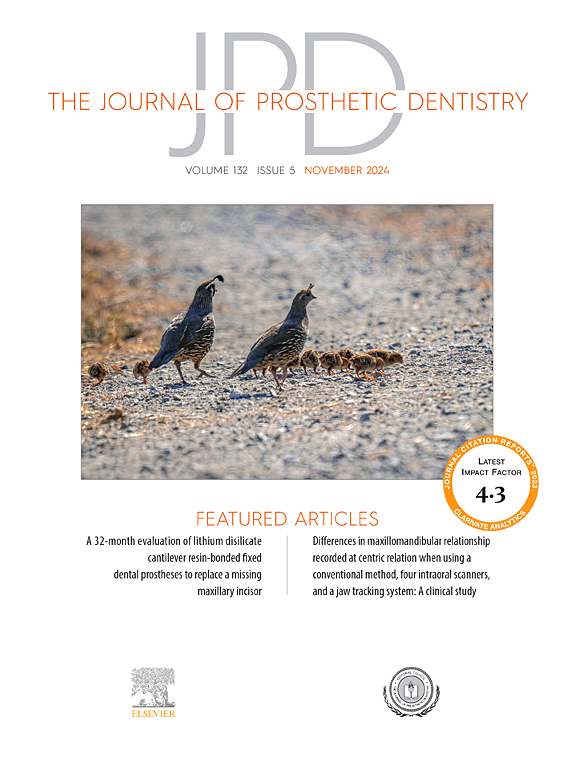3D打印、研磨和预制甲基丙烯酸酯基树脂材料的耐磨性:体外研究
IF 4.3
2区 医学
Q1 DENTISTRY, ORAL SURGERY & MEDICINE
引用次数: 0
摘要
问题陈述:三维(3D)打印和铣削技术已经越来越多地应用于修复实践中,用于制造数字修复体。然而,关于使用这些方法制作的假牙的耐磨性的证据是缺乏的。目的:比较3D打印和铣削技术制备的义齿与预制义齿的耐磨性。材料与方法:制备3种制造工艺的树脂义齿标本50个,分为5组:1组3D打印义齿(NextDent C&B MFH), 2组研磨义齿(Ivotion Dent和VIPI Block), 2组预制义齿(Major Dent和Cosmo HXL)。每组标本在49-N负荷和热循环条件下用氧化锆拮抗剂封闭12万次。拮抗剂以2 mm的距离和1.6 Hz的频率水平前后移位。定量记录了磨损试样的体积损失和最大磨损深度,并用扫描电子显微镜(SEM)对磨损特性进行了评价。数据分析采用Kruskal-Wallis检验,然后两两比较检验(α= 0.05)。结论:3D打印、研磨和预制义齿的制造方法具有相当的耐磨性,其中3D打印义齿的耐磨性最高。本文章由计算机程序翻译,如有差异,请以英文原文为准。
Wear resistance of 3D printed, milled, and prefabricated methacrylate-based resin materials: An in vitro study
Statement of problem
Three-dimensional (3D) printing and milling technologies have been increasingly used in prosthodontic practice for fabricating digital prostheses. Nevertheless, evidence relating to the wear resistance of denture teeth fabricated using these methods is lacking.
Purpose
The purpose of this in vitro study was to compare the wear resistance exhibited by denture teeth fabricated using 3D printing and milling technologies with prefabricated denture teeth.
Material and methods
Fifty specimens of resin denture teeth from 3 types of manufacturing processes were prepared and divided into 5 groups: 1 group of 3D printed denture teeth (NextDent C&B MFH), 2 groups of milled denture teeth (Ivotion Dent and VIPI Block), and 2 groups of prefabricated denture teeth (Major Dent and Cosmo HXL). Each group of specimens was occluded with a zirconia antagonist under a 49-N load with thermocycling conditions for 120 000 cycles. The antagonist was horizontally displaced back and forth at a 2-mm distance and a frequency of 1.6 Hz. The quantification of the volume loss and the maximal wear depth of the worn specimens were recorded, while the wear characteristics were assessed with a scanning electron microscope (SEM). Data were analyzed using the Kruskal-Wallis test followed by pairwise comparison tests (α=.05).
Results
Significantly different wear depths and volume losses were found among groups (P<.05). The highest wear depth and volume loss were observed in the VIPI Block (0.513 ±0.147 mm and 3.094 ±0.790 mm³), followed by Cosmo HXL group (0.312 ±0.020 mm and 1.446 ±0.134 mm³), Major Dent (0.261 ±0.034 mm and 1.219 ±0.196 mm³), Ivotion Dent (0.253 ±0.021 mm and 1.082 ±0.089 mm³), and NextDent C&B MFH (0.208 ±0.059 mm and 0.843 ±0.372 mm³). Based on the analysis of the SEM images, distinct groups of specimens exhibited varying degrees of crack formation. Furthermore, their worn surfaces showed diverse characteristics in terms of wear patterns and roughness attributes.
Conclusions
The manufacturing methods for fabricating 3D printed, milled, and prefabricated denture teeth exhibit comparable wear resistance, with 3D printed denture teeth demonstrating the highest level of wear resistance.
求助全文
通过发布文献求助,成功后即可免费获取论文全文。
去求助
来源期刊

Journal of Prosthetic Dentistry
医学-牙科与口腔外科
CiteScore
7.00
自引率
13.00%
发文量
599
审稿时长
69 days
期刊介绍:
The Journal of Prosthetic Dentistry is the leading professional journal devoted exclusively to prosthetic and restorative dentistry. The Journal is the official publication for 24 leading U.S. international prosthodontic organizations. The monthly publication features timely, original peer-reviewed articles on the newest techniques, dental materials, and research findings. The Journal serves prosthodontists and dentists in advanced practice, and features color photos that illustrate many step-by-step procedures. The Journal of Prosthetic Dentistry is included in Index Medicus and CINAHL.
 求助内容:
求助内容: 应助结果提醒方式:
应助结果提醒方式:


